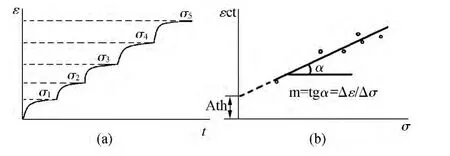冻土解冻后的沉降预测
2014-03-19KotovRomanTsarapov
Kotov P.I.,Roman L.T.,Tsarapov M.N.
(莫斯科大学地质学院冻土系,莫斯科119234,俄罗斯)
0 Introduction
By the current moment a lot of experimental and theoretical information concerningmechanisms and principles of settlement development in thawing soils of various composition and structures has been gained.Two main approaches for settlement estimation have been specified:measuring(based on physical characteristics)and experimental(thawing and compression coefficients identification).Based on the first approach,about 15 dependences of thawing fine-grained soils settlement on physical properties have been obtained.Their summary is given in the report[1].It is noted that it is almost impossible to educe the generalized imperical dependence of thaw settlements on physical properties due to the fact that thaw settlements are determined by many factors which cannot be quantitatively estimated[1-3].But the formulas obtained for certain regions and different types of soil,give good agreement with the results of field tests.Prediction of thawing soils settlements is focused on experimental identification of deformation characteristics.Field stamp tests in test pits are labor-consuming and expensive. That is why they cannot be applied during massive engineering and geological field explorations.Due to this fact,the most common tests are laboratory compression ones.Therefore,two approaches have been combined in this work for reducing time of the forecast.
A lot of experiments(clayey silt(236),silt (105)and silty sand(48)),selected in the north of Western Siberia,the European part of Russia,Yamal peninsula with marine genesis,was generalized for the prediction of deformation characteristics of thawing soils.
1 Experimental test procedure
Experimental researches of deformation characteristics were performed on the samples with undisturbed structure taken from 6 m.The samples were cylindershaped with the diameter of 70 mm and height of 35 mm.Then the samples were kept there for two days at the temperature of-2℃ and were placed into the devices.Test was performed in odometers made of plexiglas which provided thermal insulation of the samples on their side surface allowing to perform plane parallel thawing(Fig.1).
Tests identifying deformation characteristics of thawing soils are performed in three stages[1]:
StageⅠ-consolidation of the frozen sample at freezing temperature with the natural load.
StageⅡ-thawing of the sample at the same load.
Consolidation of the frozen and thawing sample is performed until relative stabilization is reached.Indicator readings of 0.01 mm per 12 h.are taken as relative stabilization.
StageIII-consolidation of the thawed sample with incrementally increasing load.After the thawed soil deformation stabilization(under natural load)the load was increased by 0.05 MPa for clayey soils and by 0.075 MPa for sandy soils.Each load stage was maintained until settlement reached relative stabilization that was taken as equal to 0.01 mm per 12 hours.
In total,there were five load stages.

Fig.1 Odometer scheme1-base;2-leading cylinder;3-operational non-thermally conductive ring;4–perforated disk;5-stamp;6-lid;7-indicators;8-soil
According to the data obtained relative settlement dependence on time at each load stage was identified (Fig.2a)as well as relatively stabilized settlement dependence on voltage(Fig.2 b).Based on these dependencies thawing coefficient(A)(equal to relatively stabilized thaw settlement without load)and compression coefficient(m)(calculated as the slope ratio of the right line to the axis of abscissa)were determined(Fig.2 b).

Fig.2 Relative settlement development dependence on time at each load stage(a),relatively stabilized settlement dependence on load(b)
2 Forecast deformation characteristics
Correlation analysis for each type of soil performed for each indicator of the physical properties and predicted deformation characteristics.Paired correlation coefficients considered between dependent variables.
Indicators of physical properties of soil were divided into two groups in which they are closely correlated with each other:
1)density-density of frozen soil dry density;
2)water content-total water content,degree of water saturation.
Characteristics,which greatly affect deformation properties of the soil,were selected after correlation analysis(Table 1).Compression coefficient correlates insignificantly with the physical properties of frozen and thawed soils.Therefore,the forecast of the deformation characteristics can not be performed.
Correlation between thawing coefficient and physical properties of frozen soils is high.Dependences have the greatest degree of approximation using a linear relationship.Therefore we used a linear regression analysis.
A lot of parameters(W-Wp,(W-Wp)/Sr,(WWp)/Ip,W-Wp)/WL,etc.)have been considered to improve the reliability of the model.The highest coefficient of determination,showing the degree of conformity the trend model and initial data,obtained for silt soils-dry density and(W-Wp)/Sr,.sand-dry density and W/Sr(Fig.3,4).It is for these variables used regression analysis.Coefficient of multiple determination was equal to 0.7.
Fisher's ratio test and Student's t-test were perfomed and obtained the equations(Table 2).

Table 1 The correlation coefficients between indicators of physical properties and deformation characteristics

Fig.3 Dependence of the thawing coefficients on dry density for different soil types

Fig.4 Dependence of the thawing coefficients on(W-Wp)/Srfor silt soils(a)and W/Srfor sand(b)

Table 2 Equation for the calculation of thawing coefficient
3 Calculation of thawing soils settlement
Settlement of frozen soil after thawing and consolidation includes two parts:

where Sth—settlement under their own weight; Sσ,k—settlement under the influence of the additional load(weight of buildings).

where A thawing coefficient,u.f.;m—compression coefficient,MPa-1;σ—natural load,MPa;h—thawing soil layer thickness,cm.

where σ0—additional vertical pressure on the base under the foundation,MPa;b—width of the foundation base,cm;KhKμ,iKi,Ki-1—coefficients determined by the tables in the SP25.13330.2012[4];mi—compression coefficient,MPa-1,l—length of the foundation base,cm.
Formula(5)use to forecast settlement for the construction of railways and pipelines.
We can calculate settlement without using compression coefficient by the formula:

Relative error thawing settlement,using formula 7,does not exceed 15%for most tests(Fig.5).These values are typical for samples at natural pressures less than 0.10 MPa.We can use a formulas(1-3)to calculate settlement by the formula:

Absolute error thawing settlement(1 m thawed soil),using formulas 1-3 and 8,does not exceed 15 cm for 96%of tests(average values for the sandy soil 5 cm and 8 cm for silt)(Fig.6).
Thus,proposed methodology can be used with prior forecast of settlement thawing soils on permafrost.

Fig.5 Dependence of the relative error thawing settlement on water content by formula 7 for different types of soils

Fig.6 Dependence of absolute error thawing settlement on water content by formula 1-3 and 8 for different types of soils
4 Conclusions
Summarize data of compression tests(about 400 different undisturbed soil)allowed us to develop method of forecast settlement thawing soil.This method is not universal and applies in the north of Western Siberia and the European part of Russia for marine genesis soils,natural loading less than 0.1 MPa.Absolute error thawing settlement(1 m thawed soil),using formulas 1-3 and 8,does not exceed 15 cm for 96%of tests(average values for the sandy soil 5 cm and 8 cm for silt).Therefore,proposed method can only be used for a preliminary assessment of settlement frozen soils after thawing.
[1] Roman L T.Frozen soils mechanics[M].Moscow:MAIK“Nauka/Interperiodika”Press,2002.
[2] GOST 12248-2010.Methods of laboratory identification of durability and deformability characteristics[Z],Moscow:MNTKS Press,2011.
[3] Tsytovich N A.Frozen soils mechanics[M].Moscow:Vysshaya shkola Press,1973.
[4] SP 25.13330.2012.Foundations in permafrost[Z].Moscow: FCS Press,2012.
杂志排行
黑龙江大学工程学报的其它文章
- The harm of perennial frozen soil to the pipeline exporting the crude oil from Mohe county to Daqing city
- Overview of research methods of frozen soil hydrology in Heilongjiang Province
- Environmental geochemistry of urban areas in Yakutia
- A permafrost factor in the development of deformations on the Amur Highway
- The problem of project statement of construction principles of buildings and facilities in permafrost
- The forecast of a temperature regime of soils containing the pile foundation of a pithead on diamond-mining mines of cryolithic zone
